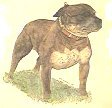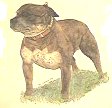
Evolution

Conclusions
References
By understanding evolution and genetics we are able to examine the nature of the
relationships between different breeds of dog and how the mechanisms of those
relationships work. All breeds of domestic dog are genetically the same species (canis
familiaris). Compared with the whole species, a specific breed of dog can be viewed as
a genetically isolated, closely related, interbred population (see Line Breeding).
The term "breed of dog" is defined as being a group within the species canis familiaris that has a clearly defined set of characteristics and is capable of breeding to type. The term "type" is the sum-total of characteristics of the group. (Type has a taxonomic definition; the taxonomic group, the characteristics of which are used for defining the next highest group, e.g. Rattus norvegicus (brown rat) is the type species for the rat genus Rattus).
What is Taxonomy? The diversity of living organisms is enormous. It is reckoned that there may be over 3,000,000 species on this planet. To deal with this vast diversity requires a classification of data on each species to provide some sort of order. To study this diversity a branch of biology called "Systematics" has developed, "Taxonomy" is the study and practice of how organisms are classified and "Biological Classification" is the actual process of ordering organisms into groups on the basis of their relationships. The descriptions and classifications of each species are based on observation of similarities. "Biological Nomenclature" (e.g. canis familiaris) is also important and has been developed so that all recognised groups of organisms may be allocated unambiguous and universally accepted names - the names are usually Latin and for some reason are always written in italics. Taxonomy can be easily understood if you think of it as a pure form of gossip e.g. she wears a short skirt, lots of make-up and goes out every night therefore she is a ....... or he has a filofax, a mobile phone and drives a big car so he must have a small ..... or this animal has fur, mammary glands, sweat glands, un-nucleated red blood corpuscles etc. so it must be a mammal. A "Taxonomic Character" is any feature of a group of organisms which allows us to distinguish them from other groups of organisms. It might be head shape, blood protein, pattern of behaviour, geographical distribution, size, short skirt, big car or any other observable attribute (e.g. descriptions in breed standards).
Classifications generate ideas as a result of the way in which they bring information together. A classical example is that of Darwin's (and Wallace's!) theory of evolution. One of the pieces of evidence Darwin produced for his theory was that "natural" groups of organisms could be recognised by taxonomists who used many similarities to categorise groups. For example, if taxonomists had categorised organisms using only a few similarities (e.g. organisms capable of flight) species of birds, insects and mammals fit into this artificial categorisation (artificial since it tells us nothing about the natural links between the various organisms within the category). Fortunately, taxonomists categorised on the basis of many similarities and found birds were a clearly defined group of similar organisms different from say insects which again were a clearly defined group. Darwin was led to consider the reasons why such separate groups should exist. He realised that the possibility of forming systems of classification depended on the occurrence of different features (e.g. legs, fur, backbones) in definite combinations. If all features varied independently then no classification based on overall similarity could exist. There is no logical reason why a particular combination should be correlated (as the features legs, fur and backbones are in mammals). Why should we never come across flowering plants possessing fur and backbones ? This kind of problem led Darwin to the idea that we can classify on the basis of overall similarity because living organisms are related to one another by a common evolutionary descent. All branches of biology are dependent on the generalisations produced by taxonomists.
Natural taxonomic classifications, such as those used by Darwin, are based on many similarities. Artificial classifications (such as the classification system used by the Kennel Club) are defined "monothetically" that is by the use of one or a few characteristics. The Kennel Club system of classification is based on function. Artificial classifications tend to lack biological meaning.
It is important to realise that good natural classifications existed before the theory of evolution was put forward by Darwin and Wallace. In fact, it is incorrect to define natural classification as a classification based on phylogeny (evolutionary relations) since scientists know almost nothing of the evolution of most groups of animals. If we had to use evolutionary evidence to provide a natural classification we would hardly be able to classify any animal taxa at all! In practice, nearly all our existing classifications are based on comparisons of present day forms of species, rather than on their ancestors. However, this system of classification is useful since it has helped scientists predict what characteristics an organism must posses to be a member of a particular group, and where further evolutionary evidence (e.g. fossil records, genetic analysis, historical evidence) has been found it usually backs up the existing classification. We will explore the natural system of classification further in a future article by applying it to produce a classification of various breeds of dog based on similarities - this should tell us something about the evolution of the various breeds examined.
Why can we make natural classifications using only the overall similarities and resemblances between the kinds of organisms which are alive today ? Because all organisms are related to each other by evolutionary descent. The closer the evolutionary relationship between two kinds of organism, the more alike they usually appear. Thus, Staffords and Bull Terriers resemble each other more than either resemble a Kerry Blue or a Border Terrier. We are using the same techniques that allow us to recognise people as members of a particular family by the fact that they look similar. Evolution, therefore, explains why natural groups exist - they are "blood relations" sharing the same pedigree.
Before the theory of evolution the species described by the taxonomists and naturalists were considered to be fixed, immovable and unable to change. The idea of natural selection as the fundamental process of evolutionary change was reached independently by Charles Darwin and Alfred Russel Wallace last century. In 1858 they made a joint presentation of their discovery to the Linnean Society of London. The argument for evolution by natural selection was developed fully, with considerable supporting evidence (some of which referred to various breeds of dog), in "On the Origin of the Species", published by Darwin in 1859. He proposed that carriers of hereditary variations that are useful as adaptations to the environment are likely to survive better and produce more successful progeny than organisms possessing less useful variations. As a consequence, adaptive variations will gradually increase in frequency over the generations, at the expense of less adaptive ones. This process of differential multiplication of hereditary variations was called "natural selection". The outcome of the process is organisms well adapted to their environments. On variation within domestic species Charles Darwin remarked that "cultivated" plant and animal species "generally differ more from each other than do the individuals of any species or variety in a state of nature." He concluded that "this great variability is simply due to our domestic productions having been raised under conditions of life not so uniform as, and somewhat different from, those to which the parent species have been exposed in nature". Darwin also thought it "highly probable that our domestic dogs have descended from several wild species" - but that is the subject for another discussion altogether.
Conclusions so far
Dog fanciers may find the history of how their favourite breed came into being
interesting, but examining the origins of the various breeds is not an just empty academic
exercise. By looking at the selection processes involved in the creation of a breed and
examining how the mechanism of these processes work we can better understand our chosen
breeding programmes.
We have examined the first concept we need to understand when looking at how species have diversified. Evolution accounts for the origin of existing species (or breeds of dog) from ancestors unlike themselves, and is achieved by a gradual change in the characteristics of a population over successive generations. The mechanism of evolution is inheritance, and the study of heredity is genetics - we will look at this in a future issue.
Further reading
Darwin, C. (1859). On The Origin Of Species By Means Of Natural Selection Or The
Preservation Of Favoured Races In The Struggle For Life. (Edition: 1904, R & R Clarke
Ltd., Edinburgh).
Nicholas, F. W. (1987). Veterinary Genetics. Clarendon Press, Oxford.
Robinson, R. (1990). Genetics for Dog Breeders. Pergamon Press, Oxford.
Dawkins, R. (1982). The Extended Phenotype: The gene as the unit of selection. Oxford University Press.